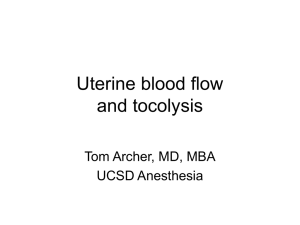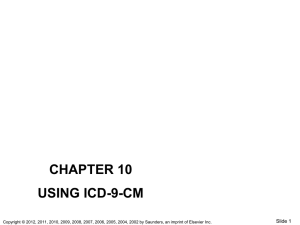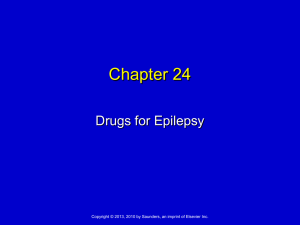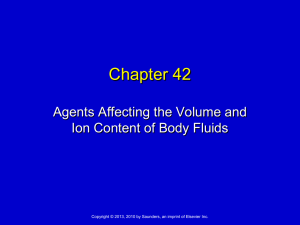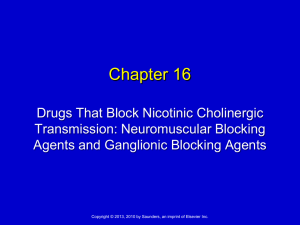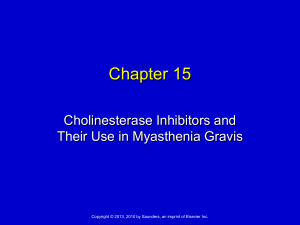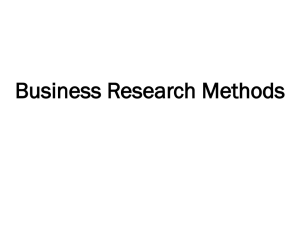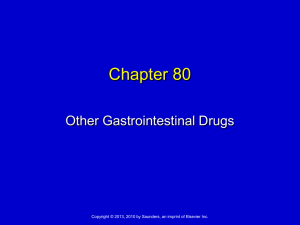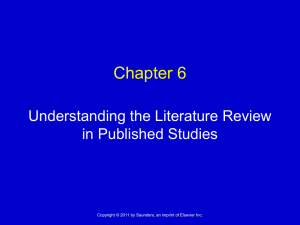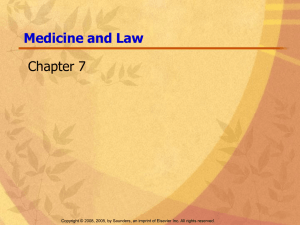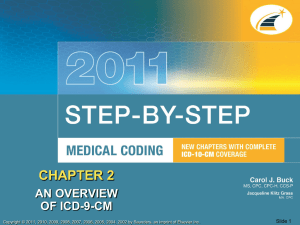Chapter_064
advertisement
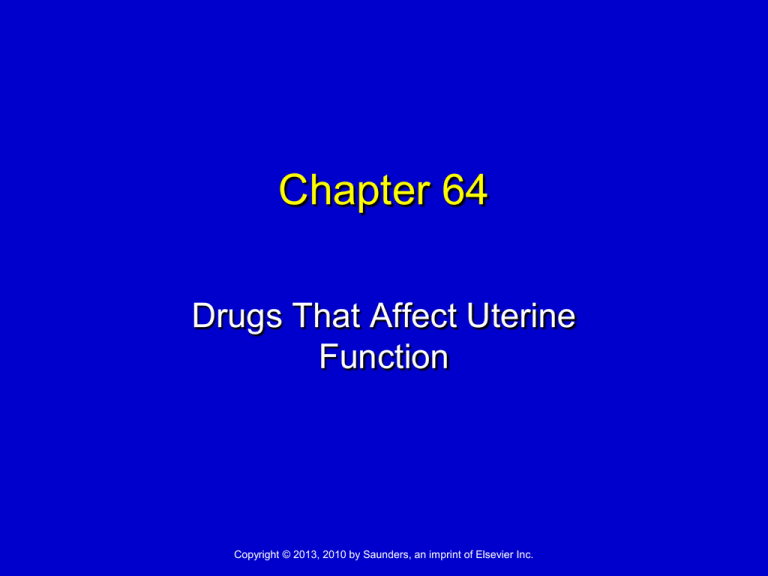
Chapter 64 Drugs That Affect Uterine Function Copyright © 2013, 2010 by Saunders, an imprint of Elsevier Inc. Drugs That Affect Uterine Function Three main categories: Uterine relaxants (tocolytics) • Uterine relaxation • Suppression of preterm labor Uterine stimulants (oxytocics) • Uterine contraction • Induction/augmentation of labor • Control of postpartum bleeding • Induction of abortion Drugs used to decrease menorrhagia (heavy menstrual bleeding) Copyright © 2013, 2010 by Saunders, an imprint of Elsevier Inc. 2 Preterm Birth Before 37 weeks’ gestation Leading cause of infant morbidity and neonatal mortality United States: 12.5% of all live births Premature births account for 75% of all neonatal mortalities and 50% of congenital neurologic deficits Most common neonatal respiratory distress syndrome Copyright © 2013, 2010 by Saunders, an imprint of Elsevier Inc. 3 Uterine Relaxants (Tocolytics) Used to delay delivery Average delay: only 48 hours If used with glucocorticoids, the glucocorticoids can accelerate lung development Also used to buy time to treat infection Copyright © 2013, 2010 by Saunders, an imprint of Elsevier Inc. 4 Control of Myometrial Contraction Regulated by multiple mediators Beta-adrenergic agonists Oxytocin Prostaglandins Four classes of drugs: all decrease the availability of phosphorylated light chain Beta-adrenergic antagonists, calcium channel blockers, cyclooxygenase (COX) inhibitors, and oxytocin-receptor antagonists Copyright © 2013, 2010 by Saunders, an imprint of Elsevier Inc. 5 Uterine Relaxants (Tocolytics) Beta2-selective adrenergic agonist Terbutaline (Brethine) • Beta2-selective adrenergic agonist • Not approved by FDA for this use Nifedipine (Procardia, Adalat, Nifedical) Can suppress labor for up to 48 hours Efficacy equals that of terbutaline, and safety is superior Copyright © 2013, 2010 by Saunders, an imprint of Elsevier Inc. 6 Uterine Relaxants (Tocolytics) Indomethacin (Indocin) Second-line tocolytic Higher risk for neonatal complications Prolonged renal insufficiency, bronchopulmonary dysplasia, necrotizing enterocolitis, and periventricular leukomalacia Nitroglycerin, a nitric oxide donor Copyright © 2013, 2010 by Saunders, an imprint of Elsevier Inc. 7 Uterine Relaxants (Tocolytics) Atosiban Oxytocin: receptor antagonist Magnesium sulfate High dose does not prevent or delay preterm birth but does increase infant mortality Was previously used readily Low-dose magnesium sulfate may reduce the risk of cerebral palsy without increasing mortality Copyright © 2013, 2010 by Saunders, an imprint of Elsevier Inc. 8 Drugs Used to Promote Cervical Ripening Dinoprostone (Prepidil, Cervidil) Dinoprostone gel Dinoprostone vaginal inserts (Cervidil) Misoprostol (Cytotec) Not approved for this use Copyright © 2013, 2010 by Saunders, an imprint of Elsevier Inc. 9 Uterine Stimulants (Oxytocics) Prostaglandins: Dinoprostone and Misoprostol (can also induce labor) Dinoprostone Most widely used for cervical ripening Shortens duration of labor, allows reduced dosage of oxytocin, decreases need for cesarean section Can also induce abortion Misoprostol Not approved for cervical ripening More convenient and less expensive than dinoprostone Higher incidence of uterine tachysystone Copyright © 2013, 2010 by Saunders, an imprint of Elsevier Inc. 10 Uterine Stimulants (Oxytocics) Three groups of uterine stimulants Oxytocin Ergot alkaloids Prostaglandins Copyright © 2013, 2010 by Saunders, an imprint of Elsevier Inc. 11 Uterine Stimulants (Oxytocics) Oxytocin (Pitocin) Peptide hormone produced by the posterior pituitary Increases the force, frequency, and duration of uterine contractions Uterus becomes progressively more responsive to oxytocin throughout pregnancy Facilitates labor, but unclear whether it can initiate labor Copyright © 2013, 2010 by Saunders, an imprint of Elsevier Inc. 12 Uterine Stimulants (Oxytocics) Oxytocin (Pitocin) (cont’d) Physiologic and pharmacologic effects • Uterine stimulation • Milk ejection • Water retention Precautions and contraindications • Uterine rupture may occur • Women with active genital herpes Adverse effect: water retention/intoxication Copyright © 2013, 2010 by Saunders, an imprint of Elsevier Inc. 13 Uterine Stimulants (Oxytocics) Ergot alkaloids: ergonovine and methylergonovine Dried preparation of Claviceps purpurea Stimulate adrenergic, dopaminergic, and serotonergic receptors Not used to induce labor (sustained contractions) Can cause constriction of arterioles and veins and risk of severe hypertension Used to control postpartum bleeding Copyright © 2013, 2010 by Saunders, an imprint of Elsevier Inc. 14 Uterine Stimulants (Oxytocics) Ergot alkaloids: ergonovine and methylergonovine (cont’d) Therapeutic uses • Postpartum bleeding (not responsive to oxytocin and carboprost tromethamine) • Augmentation of labor • Migraine Adverse effects (IV administration) • Hypertension Copyright © 2013, 2010 by Saunders, an imprint of Elsevier Inc. 15 Uterine Stimulants (Oxytocics) Carboprost tromethamine (Hemabate) Preferred agent for controlling postpartum hemorrhage Causes intense uterine contractions Adverse effects • GI reactions • Vomiting and diarrhea • Fever • Vasoconstriction • Constriction of the bronchi Copyright © 2013, 2010 by Saunders, an imprint of Elsevier Inc. 16 Drugs for Menorrhagia Tranexamic acid Menorrhagia Trauma patients Adverse effects and interactions NSAIDs Combination oral contraceptives Levonorgestrel-releasing intrauterine system Copyright © 2013, 2010 by Saunders, an imprint of Elsevier Inc. 17
